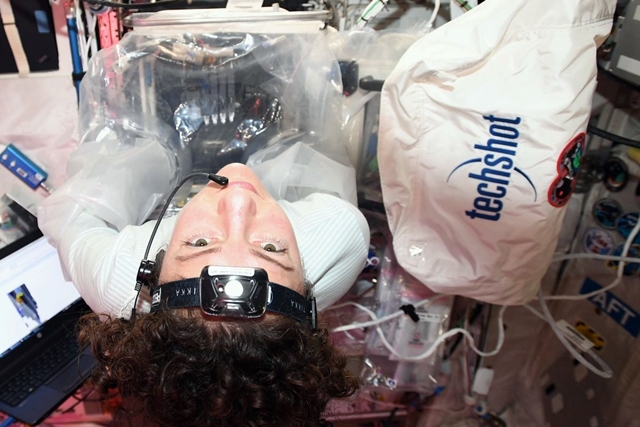Subscribe for email alerts
Donate to Science & Enterprise
|
By Alan, on January 8th, 2020 – Contributed content –
 (Public Domain Pictures, Pixabay) 8 Jan. 2020. One of the biggest challenges any entrepreneur faces is finding the money they require to get their new business off the ground.
Starting a business is expensive, from the cost of office space to paying staff and utilities, not to mention production and advertising costs – and that’s just the tip of the iceberg – so it’s not surprising that so many entrepreneurs fail to get their company off the ground.
That being said, plenty of entrepreneurs do get a break and are able to find the funds they require. Obviously, your first port of call for funding is probably going to be the bank, but if that doesn’t work out, here are some other options to explore:
Crowdfunding
Crowdfunding has become big business in recent years with sites like Fundly and Kickstarter helping many an entrepreneur reach their dreams. If you have a strong vision of your company’s future and you can share that with your audience on one such platform, there is a good chance that you could secure funding from individuals around the world who want to see your ideas become a reality.
Angel investors
Angel investors are individuals who loan their own money to entrepreneurs they think could make it in the business world. Quite often, they are successful entrepreneurs in their own right and they often will offer advice as well as money, which is an added bonus of going down this route. Just remember that any transaction you make with an angel investor must be noted with the Securities and Exchange Commission – the last things you want is to start out with legal action hanging over your head.
Sell an annuity
If you happen to have an annuity, perhaps due to being compensated for an injury, you could do what a lot of other entrepreneurs do and sell annuity payment so that it can be invested in your business. Obviously, if you do this there is no guarantee your business will take off, so you need to think very carefully about it and ensure your business idea is viable, but it can be a great way to get started.
Microloans
If you are planning to set up a non-profit company, you might want to take a look at microloans. They are available across a wide range of sectors from science to retail and they can help individuals who are unlikely to be approved for a traditional bank loan. Where does the money come from? Individuals who are looking to back a business idea they believe in pool their cash (usually via an official organization) and loan it out with (usually) very favorable terms.
Competitions
If you can believe it, there are actually competitions that offer cash or even business financing. These are usually run by larger organizations, and they do tend to have some pretty stringent requirements, but it’s definitely worth seeing what’s out there.
As you can see there have never been more options for funding your business, so don’t give up.
* * *
By Alan, on January 8th, 2020  (Gerd Altmann, Pixabay) 8 Jan. 2020. A joint venture of two drug discovery and design companies aims to create new biotechnology businesses to find drugs for treating rare diseases. Financial and intellectual property details of the agreement between Cyclica Inc. in Toronto and Translational Medicine Accelerator LLC, in Boston were not disclosed.
Cyclica and Translational Medicine Accelerator say some 10,000 rare diseases affect one-tenth of the world’s population, with few drugs now approved to treat these conditions. Many rare diseases, say the companies, are chronic and progressive disorders, often misdiagnosed or not well-managed, leading to death without adequate treatment. Rare diseases are a particular burden in developing regions, where patients find few options for care and high costs.
To address these unmet needs, the two enterprises established the Rare Diseases Medicine Accelerator to combine Cyclica’s work in drug design and Translational Medicine Accelerator’s expertise in precision medicine, with both companies applying tools based on artificial intelligence. The Rare Diseases Medicine Accelerator plans to form new biotechnology businesses to discover treatments for rare diseases, initially focusing on the needs of patients in Latin America and sub-Saharan Africa.
Cyclica employs computational biology and biophysics for drug discovery to assess the total effects of proposed treatments on the body, not just the prime targets. The company’s Ligand Design service starts with what the company calls seed molecules, then designs more complex molecules with artificial intelligence to achieve specific chemical interactions in the body, as well as reflect desired ADMET — for absorption, distribution, metabolism, excretion, and toxicity — properties.
Cyclica’s Ligand Express is a complementary cloud-based service that screens small molecule compounds against a large simulated protein repository with artificial intelligence routines to visualize and predict multiple interactions in the body. The company takes part in other drug discovery joint ventures, as described by Science & Enterprise in November 2019, when Cyclica joined with ATAI Life Sciences to form a new company to find safer and more effective treatments for psychiatric disorders.
Translational Medicine Accelerator offers a subscription package of genomic, technical, and analytical services for health care providers to find personalized treatments for rare diseases, in what the company calls precision health as a service. The company’s technologies include artificial intelligence and other computational tools to identify, design, and develop personalized interventions for these difficult to treat cases. The personalized therapies can then be scaled-up and evaluated against larger groups of patients in similar conditions.
TMA’s scientific founder is Matthew Might, director of the precision medicine institute at University of Alabama in Birmingham, but also a professor computer science at the university. In 2012, Might’s son was diagnosed with an NGLY1 deficiency, a rare disorder affecting multiple systems in the body. Might’s efforts led to discovery of two therapies, as well as A.I.-enabled drug discovery software, and establishment of treatment and counseling services in Birmingham for rare disorders. He also served as an adviser to the White House during the Obama administration, developing a government-wide precision medicine initiative.
Naheed Kurji, president and CEO of Cyclica, says in a company statement that the Rare Diseases Medicine Accelerator, “will advance the discovery of medicines for those patients who are suffering from the most understudied and neglected diseases.” Joshua Resnikoff, CEO of TMA adds that the joint venture “can create an efficient and systematic approach for developing more effective medicines for individuals, furthering the deployment of precision health care at scale.”
More from Science & Enterprise:
* * *
By Alan, on January 7th, 2020  NASA crew member Jessica Meir aboard the International Space Station with the 3-D biofabrication facility operated by Techshot. (NASA, Techshot Inc.) 7 Jan. 2020. A patch of human heart tissue returned to earth today after being produced with a three-dimensional printing system on the International Space Station. The printing system is made by Techshot Inc. in Greenville, Indiana, a developer of science payloads, mainly for research labs to deliver their experiments for crew members aboard the space station.
One of Techshot’s systems aboard the ISS is its biofabrication facility or BFF, a 3-D printer designed to produce human cells in microgravity, or weightless conditions. The BFF, says Techshot, produces fine layers of bioinks containing adult human cells, including stem cells. Bioprinting in microgravity makes it easier to produce soft tissue, like blood vessels, since the printed cells are not affected by earth’s gravity, which means cells and tissue can be printed without a supporting matrix or scaffold. Techshot developed the BFF with nScript, a developer of industrial 3-D printers in Orlando, Florida.
On the space station, the BFF operates in a self-contained cell culturing cassette, where the printed cells form into tissue. The new printed heart tissue patch measures 30 x 20 x 12.6 millimeters (1.2 x 0.8 x 0.5 inches), containing heart muscle, nerve, and vascular cells. The patch returned to earth earlier today aboard a SpaceX capsule, splashing down in the Pacific Ocean. Techshot says more 3-D tissue printing is expected to take place in March, when the next resupply mission to the space station delivers more bioinks for the printer.
“Our BFF has the potential to transform human health care in ways not previously possible,” says Techshot CEO John Vellinger in a company statement. “We’re laying the foundation for an entire industry in space.”
Techshot says it’s developing a cell factory for the space station for producing multiple types of cells in a biomanufacturing facility that includes 3-D printing. The cell factory will be the sixth commercial research or manufacturing payload in the space station. While these biomanufacturing facilities are promising, actual production of human organs on the space station is at least a decade away, although research in this field is expected to contribute to eventual bioprinting of human organs on earth.
More from Science & Enterprise:
* * *
By Alan, on January 7th, 2020 – Contributed content –
 (Serpstat, Pexels.com) 7 Jan. 2020. Opening your own business may be one of your goals for the new decade, but finding the right avenue to explore that suits your modern ideals can be a tricky process. Luckily, there are several different concepts that might appeal to your revolutionary nature, and these business ideas could help to ensure that you can make a long term, sustainable profit. There’s no point in buying into something that’s already had its run, so if you want to find out more about the most innovative and progressive startup options available for today’s modern entrepreneur, then read on to uncover a snapshot of some of the greatest examples you can take advantage of today.
Providing cyber security
So much more commerce, business and social communication is being done online in today’s society, and this means that a large amount of personal information and sensitive data is being used at any given time. Keeping this data as safe and secure as possible is becoming a focus among many organizations due to the risks associated with being hacked or encountering a virus of some sort, and this is exactly where you can step in.
Creating your very own cyber security startup will be a great choice for those of you with some tech based experience, as it’s a guaranteed long term plan that offers room for growth and progression. All businesses online have to carry out security practices in order to keep their information out of harm’s way, and you could offer this service remotely to help protect your clients web pages and data stores to stay strong and resilient against unauthorized access.
Innovative medical services
Medicine and all of the related services have been updated and renewed as time goes by, but in reality the advances in technology should have been taken advantage of to better the quality of care that health services are able to supply. Constant research is telling us to change the way that we treat certain illnesses, and the new modern technology can help you to take a deeper look at the molecular breakdown and compound materials to find a new method of treatment. Whether you decide to focus on the research section and check out chemyo.com for a little innovative inspiration or dive straight in at the deep end and open your own modern medical center – it’s a career choice that will always have a future, as there will always be diseases to cure, patients to treat and people to look after.
With any luck, the next generation business ideas listed above could be the perfect avenues for you to explore as a modern entrepreneur. There’s a growing need to provide cyber security services to organizations that want to protect their data and keep their customers personal information out of harm’s way, so perhaps this could be an option? Or why not get involved with the modern medicine industry, and try to make new discoveries in terms of detection and treatment of illnesses.
* * *
By Alan, on January 7th, 2020  Juul e-cigarette device (Mylesclark96, Wikimedia Commons) 7 Jan. 2020. Tests of aerosol compounds inhaled by lab animals show Juul devices send more nicotine into the blood stream than other e-cigarettes and ordinary cigarettes as well. A separate analysis of online forum messages indicates lung damage from e-cigarettes may have gone unreported for several years.
Researchers from University of California in San Francisco led by cardiology professor Matthew Springer, reported on health effects of e-cigarettes, which are gaining more use among teens and young adults, in yesterday’s issue of Tobacco Regulatory Science. E-cigarettes are battery-powered nicotine delivery devices that heat a liquid containing nicotine, moisturizing, and flavoring agents, as well as preservatives and artificial coloring. Makers of e-cigarettes often market the devices as safer alternatives to tobacco-burning cigarettes and sometimes as a technique to help tobacco smokers quit conventional cigarettes.
The UC-San Francisco team exposed eight lab rats to aerosol vapors emitted from Juul e-cigarettes, the most popular brand among teens, which as noted in Science & Enterprise in November 2018, shapes its device like a flash memory drive, making it easier to conceal. The researchers also exposed the animals to equal amounts of generic e-cigarette vapors, smoke from conventional cigarettes, and clean air.
The team tested blood samples from the animals 20 minutes after exposure to these substances, and measured the performance of endothelial tissue that lines blood vessels, an indicator of circulatory functions and future heart disease. The results show rats breathing Juul vapors have eight times more nicotine in their blood than those breathing generic e-cigarette vapors, and five times more nicotine than conventional cigarettes. And while rats breathing Juul vapors had less endothelial functioning than those breathing generic vapors or cigarette smoke, the differences were not large enough to be statistically reliable.
Springer notes the results do not support claims of manufacturers that e-cigarettes, particularly Juul devices, may be safer alternatives than conventional cigarettes. “Our findings show,” says Springer in a UC-San Francisco statement, “that the adverse effect of cigarettes on vascular endothelial function, which has been a known consequence of cigarette smoking since the 1990s, is not prevented by using Juul.”
Years of vaping injuries
A study in the 3 January issue of the Journal of Medical Internet Research indicates damage to the lungs of e-cigarette smokers may have started several years earlier than previously known. Researchers from University of California in Riverside report that a review of online forum posts indicates e-cigarette smokers were reporting symptoms consistent with vaping injuries as long ago as 2008.
A team from the lab of cell biologist Prue Talbot is seeking to discover the extent of lung damage, known as e-cigarette or vaping product use-associated lung injury, or Evali, among e-cigarette users. Centers for Disease Control and Prevention reports that an outbreak of emergency hospitalizations from Evali began in June 2019, and peaked in September, with a decline since then. CDC says as of the end of December 2019, more than 2,500 people were hospitalized with Evali, leading to 55 deaths. The disorder is characterized by coughing, shortness of breath, chest pain, headache, fever, chills, diarrhea, nausea, and vomiting.
Talbot and colleagues gained access to a large online discussion forum for e-cigarette users, and analyzed posts to the forum between January 2008 and July 2015. To analyze the posts, the researchers constructed a web crawler, a software program designed to extract and parse information from web site pages, in this case symptoms of Evali. The team focused on seven sub-forums dealing with health topics, containing more than 41,000 posts.
In these posts, the UC-Riverside researchers found between 500 and 1,000 references to symptoms consistent with Evali, including headache, coughing, malaise, asthma, dry mouth, and sore throat, as well as many reports of multiple symptoms. And most of these reports from e-cigarette users were cast in a negative, i.e. disapproving, manner.
Talbot says the findings suggest health authorities may have missed evidence in plain sight of health problems from e-cigarettes. “Our data, which shows many of the symptoms characterizing the current patients,” says Talbot in a UC-Riverside statement, “have been reported online for at least seven years, suggests cases similar to those in the current [Evali] epidemic have existed previously and been unreported or simply not linked to vaping.”
More from Science & Enterprise:
* * *
By Alan, on January 7th, 2020 – Contributed content –
 (bykst, Pixabay) 7 Jan. 2020. There are a lot of dangers on the internet, and even though we might be aware of some of them, the threats can change on a regular basis. To help reduce the amount of impact it has on you as a business, here are some tips to stop getting scammed online.
Seek professional advice
You can always benefit from those who have expert knowledge on how to look after yourself on the internet. As a business, outsourcing this help, like remove counterfeits from Aliexpress and stopping a virus from infecting your devices, can be more cost-effective than having it all in-house. What many businesses tend to do is ignore the potential threats that come from the online world and dismiss the suggestions that are made by companies who may advise that the company is at risk of being attacked.
Train your staff to be vigilant
Your staff are an essential part of the business, and they are also partly responsible for the safety of the organization. That’s why it’s good to train them on how to stay vigilant when browsing online and working on behalf of the company. Going on the more dangerous sites unknowingly or clicking on a seemingly harmless email link could be the catalyst that endangers the company. Training your staff on new threats is handy and something you will certainly see the benefit in to do regularly. Bring in an expert IT or security firm to train and talk through the current dangers that the online world poses and what to look out for. Simply knowing these dangers and how to spot them can really help to make your staff feel more comfortable too.
Strengthen your security
Security is always something to prioritize as a company, whether that’s the physical security of your building or the online security for all your servers and electronic equipment. It’s worth seeing whether there are any vulnerable areas to your business when it comes to the online world. It could be the strength of your passwords or how relaxed your anti-ware software is on websites that might contain dangerous viruses. Always stay on top of your security, especially when other businesses find themselves in hot water. Scammers and fraudsters will regularly try and catch you out or try to infiltrate your system in some way.
Always be wary
There will always be dangers, no matter how good your security may be. However, the way you can prevent any dangers is by being wary. Ensure everyone is cautious when it comes to answering emails and navigating the online domain. Keep your files encrypted where possible and stored elsewhere away from the physical servers themselves. Being able to have a backup of your data is important, should anything go wrong with the original data stored on your servers.
Getting scammed is something you don’t think could happen to your business until it’s too late. Be wary of what’s out there and keep your wits about you, including that of your employees too.
Editor’s note: Opinions in this post are the contributor’s, not those of Science & Enterprise.
* * *
By Alan, on January 6th, 2020  (National Science Foundation) 6 Jan. 2020. Results of a clinical trial show laser images analyzed by machine learning algorithms can offer near real-time diagnosis of brain tumor tissue during surgery. A description of the technology and findings from the trial, conducted by researchers at New York University and University of Michigan, appear in today’s issue of the journal Nature Medicine (paid subscription required).
A team led by neurosurgery professor Daniel Orringer, on the faculty at New York University and University of Michigan medical schools, is seeking faster detection of brain tumor tissue during surgery to remove the tumors. In most cases today, the process requires removal of brain tissue from the patient, then prepared, stained, and reviewed by a pathologist in a separate lab. Assuming the pathologist is immediately available for the task, the diagnosis can take 20 to 30 minutes, while the surgical team waits for the results.
The new technology uses brain tissue biopsies, similar to current methods. But the new process, called stimulated Raman histology, or SRH, requires only a single preparation step, followed by exposure to near-infrared laser beams that capture microscopic images at up to 30 frames per second. The lasers excite molecules that vibrate and scatter the light beams in a process called Raman spectroscopy, with vibrations then amplified using a second light source. The different vibrations emitting from molecules in the tissue make it possible to identify and distinguish between various types of cells, including tumor cells.
To quickly interpret the images, the researchers developed algorithms using a convolutional neural network. These algorithms combine image analysis and machine learning to dissect an image by layers for understanding features in the image. Different aspects of each layer discovered and analyzed by the system are translated into data that the algorithm then uses to train its understanding of the problem being solved, with that understanding enhanced and refined as more images and data are encountered.
The team reports using more than 2.5 million SRH images from 415 patients to train its algorithms that group brain tissue image samples into 13 major classes of brain tumors. The algorithms also identify key diagnostic regions within tumor images. The authors say the system returns results in under 2.5 minutes.
Orringer and colleagues at three university medical centers recruited 278 patients undergoing brain surgery for tumors or epilepsy to assess the technology. Biopsies from the patients were randomly assigned for conventional review in pathology labs or the SRH process, with both techniques returning almost equally accurate results: 94 percent for conventional pathology and 95 percent for SRH. The SRH results, however, were returned to surgeons in near real-time.
“As surgeons, we’re limited to acting on what we can see,” says Orringer in an NYU statement. “This technology allows us to see what would otherwise be invisible, to improve speed and accuracy in the OR, and reduce the risk of misdiagnosis.”
The SRH technology is based on research originally conducted at Harvard University and licensed for commercial development to Invenio Imaging Inc., a company in Santa Clara, California. Orringer is a scientific adviser to Invenio Imaging.
More from Science & Enterprise:
* * *
By Alan, on January 6th, 2020  Chemotherapy vials (National Cancer Institute, NIH) 6 Jan. 2020. A working group published guidelines for conducting clinical trials that simultaneously test multiple cancer treatments and can change course over time. The proposals from a panel of the Experimental Cancer Medicine Centre in London, appear in today’s issue of the British Journal of Cancer.
The recommendations cover the planning, recruitment, conduct, reporting of results, and evaluation of what the working group calls complex innovative design clinical trials. These studies use a single overall design that allows for tests of treatments addressing genetic mutations suspected of causing one or more types of cancer. In addition, these single protocols make it possible to change the trial design over time as results are reported.
As a result, complex innovative design clinical trials are considered promising tools for faster and more economical testing of new treatments. Yet up to now, no comprehensive guidelines were offered for conducting these new types of trials. The working group from the Experimental Cancer Medicine Centre that prepared the recommendations is made up of academic researchers, clinicians, regulators, and pharmaceutical company representatives. The Centre held workshops in the U.K. beginning in 2017 to frame the issues and write the proposed guidelines.
The group recommends ..
- Plan the complex clinical trial with all parties, including regulators and assessment specialists, particularly if the sponsors plan to request accelerated review of the results.
- Develop a detailed design protocol incorporating all anticipated modifications and defining events that indicate completion of the study.
- Generate training and support for participants, with education for the public and accreditation if needed about the trial.
- Prepare documentation for participants, including invitations, instructions for the arms or testing groups in which they take part, and a reference handbook.
- Assemble the statistical expertise and systems needed to conduct the trial, with tools and tests identified for incorporating changes in the study as it proceeds, including variations to accommodate new treatments or molecular characteristics, and even additional diseases.
- Recruit a management group to oversee conduct of the trial, with new investigators brought on as the study evolves.
- Report and disseminate findings from the study at predefined time points, and as the trial’s test groups are completed.
- Conduct training in complex innovative design trials for staff assigned to the study, and within curricula to prepare new health care professionals.
- Structure regulatory reviews and financial reimbursements to reflect the faster reporting of results from complex innovative design, or CID, trials.
- Conduct an impact analysis for these new type of trials to assess their faster delivery of results, while assuring patient safety.
“We owe it to our patients,” says Pamela Kearns, one of the authors and director of the clinical trials unit at University of Birmingham, in a Cancer Research UK statement, “to bring potentially more effective novel treatments into the clinic as quickly as possible, and these recommendations will ensure we have good quality CID trials in place to deliver this promise.” Cancer Research UK and National Institute of Health Research are funders of the Experimental Cancer Medicine Centre, with health departments in Scotland, Wales, and Northern Ireland.
More from Science & Enterprise:
* * *
By Alan, on January 6th, 2020 – Contributed content –
 (Chuttersnap, Unsplash) 6 Jan. 2020. When it comes to the real estate market, there’s really no guidebook that explains every little tip and trick that helps you grab a bargain. After all, the state of the real estate market is always in flux, meaning that it’s going to take a lot of trial and error to build up the knowledge you need to dominate the local market. If you ever decide to take your real estate business nationwide or even overseas, then you have even more to study and learn–and there are no shortcuts.
Thankfully, there are plenty of ways that you can determine if a real estate deal is worth your time or not just from a glance. Of course, this isn’t going to be a comprehensive look at the deal, but more a general assessment that could help you get a better understanding of the property, its history and also what it could be worth under your guidance.
So without further ado, here’s a comprehensive beginner’s guide on what to look for when it comes to assessing a really good real estate deal.
Don’t focus on just the property, look at the local area as well
One of the most important things to remember when looking at a real estate deal is to stop tunnel visioning on the property itself. Far too many beginners look at the property and fail to realize that there’s an entire city surrounding it. In fact, its surroundings could have a much bigger impact on the price of a property, and it goes a long way when it comes to evaluating if a real estate deal is worth it or not.
When evaluating a real estate deal, don’t just look at the property itself. Focus on any zoning issues and liens, and make sure that the property you plan to purchase has a future in its local area. A good example of this would be converting properties into smaller homes and apartments. If the local area is extremely competitive and there are a lot of buyers searching for homes, then you need to figure out why they’re doing that. Is it because new transport options are making it a more accessible place to live? Is it because there are excellent schooling options around the area? Or perhaps they’re choosing it because a celebrity recently moved on.
Sometimes, we just don’t know what’s causing a sudden increase in popularity because it could just be a freak coincidence. However, the bottom line is clear and simple; don’t focus on the property itself and make sure you’re also looking at the local area and how it could be affecting the property that you’re evaluating.
Examine the structure of the property
A lot of real estate deals can end up going horribly due to a lack of attention paid to the structure of a building. For instance, if you neglect the fact that a property isn’t structurally sound before you rent it out to others, then you might face heavy fines and repair costs in the future. If you don’t do your due diligence and realize that the foundation of a property is wonky, then you’re going to be facing some serious penalties if someone gets hurt or loses their home.
Even then, these types of properties can still be worth the investment. The best way to analyze this is to check what work needs to be done and then ask for quotes. For instance, if you’re concerned about the structural; integrity of a building in an area that commonly suffers from tremors, then speaking to commercial earthquake retrofitting services can be incredibly helpful. With these types of services, you can easily “fix” structural issues in your property before they’re able to do any damage. The quotes will also help you decide if a real estate deal is good or not.
Renovating older properties isn’t as worthwhile as you think
It might be a shock to some people, but trying to buy and renovate older properties to sell them at a higher price isn’t as worthwhile as you think. This is because a major factor in determining the price of a property isn’t what’s in the property itself, but the local area that it’s in. Sure, you can buy a run-down property and try to upscale it to be a luxury modern home, but it’s still going to be surrounded by other run-down properties. They’ll ruin the appearance of the property itself, and buyers aren’t going to pay attention to the illusion of wealth and luxury that you’ve tried to create.
With that said, renovating for a profit can be an effective way to profit in the real estate market, but don’t let it define if your real estate deal is a good one or not. One good reason for this is because any buyer is capable of doing their own renovations. Someone who can afford a luxury property will have no problem doing their own renovations because they have the money. They’re going to buy a property because it has space for them to realize their visions, and they’re more interested in paying for the location than the property itself. On the other hand, frugal homeowners are going to look for a bare-basics property so that they can perform renovations on it themselves.
In short, trying to renovate older properties can be a profitable venture if you know what you’re doing. However, if you’re interested in real estate and making higher profit margins, then avoid the renovation hype and focus on other aspects of the real estate market instead.
Look at how the property is presented
If you’re trying to determine the value of a real estate deal at a glance, then one skill you need to pick up is analyzing the way a property is presented.
There are many little tricks that can help you determine if something is a good real estate deal or not, especially if you’re looking online or being emailed listings from other realtors and websites. One such trick is looking at the quality of the photos. If there aren’t many exterior photos, then there’s a good chance that the property doesn’t have much curb appeal. After all, why would a listing show pictures of anything that doesn’t look right? They’re going to take photos of all the good qualities of a property and show them off in the listing images. Anything they don’t specifically show is likely hidden for a good reason.
However, that’s not to say that you should avoid these properties. In fact, you should be scouting out for these types of properties and exposing their flaws. Once you’ve done this, you’ll have a much easier time negotiating discounts on issues such as a lack of curb appeal, outdated interiors and so on. By looking for these weaknesses in a property listing, you’ll find it very easy to shave off a couple of percentages from the asking price and convert it into pure profits.
Simplify the financials and make your decision there
One of the key characteristics of any successful property guru is being able to analyze a deal as quickly as possible. After all, you don’t want to be sat in the office looking at a hundred listings in full detail. We’ve already spoken about how you can analyze a property based on its listing, but you should also know how to calculate some basic financials to help you decide if it’s worth investing in a property.
The most basic calculation is to look at the amount of rent you could charge (or is currently being charged), multiply it by the number of tenants, and then multiply that by a year. Compare that number to the asking price for the property, and then you have a rough number of how many years it’ll take before you can recuperate your losses. This is heavily simplified but offers a very quick look into what you could be earning with that property. If you can make your money back in a year or two, then it’s probably a fantastic deal and warrants further investigation. This type of strategy can help you cut down on the number of deals that you need to analyze and will greatly speed up your productivity.
The real estate market is always fluctuating. Prices that are acceptable today might be outrageous or extremely cheap in the future. We don’t know how the market will evolve and we certainly don’t have a way to accurately predict what will happen in a few years time. Perhaps some new government regulation crashes the prices on certain things and makes it impossible for real estate agents to make a profit. Maybe a natural disaster occurs that makes all of your investments worthless. We can’t predict what will happen, but we can make smart decisions to help minimize the risks we take when trying to make it big in the real estate world.
Editor’s note: The opinions in this post are the contributor’s, not those of Science & Enterprise.
* * *
By Alan, on January 4th, 2020  Click on image for full-size view (Statista) 4 Jan. 2019. Science & Enterprise covers research on climate change and business initiatives taking that research to the marketplace. But the biggest climate story today is happening in Australia, where wildfires linked to unusually hot and dry conditions are consuming large sections of the country.
Our friends at Statista put together a chart this week comparing Australia’s fires in size to other recent wildfire outbreaks, our infographic for this weekend. Data for the chart, compiled from state, national, and news media sources show Australia’s fires burning over 12 million acres. Some 10 million of those acres are in the southeastern state of New South Wales, burning entire towns, and affecting air quality and darkening day time skies in the state capital Sydney.
In comparison, the size of Australia’s fires are nearly twice as large as the 6.7 million acres consumed in Siberia’s wildfires earlier in 2019, also helped along by a changing climate. Plus, the wildfires in California in 2018 and burning forests in the Amazon last year are about one-sixth the size of Australia’s fires.
Australia’s Bushfire and Natural Hazard Cooperative Research Centre in Melbourne provides updates on the fires as well as research underway to deal with the crisis.
More from Science & Enterprise:
* * *
|
Welcome to Science & Enterprise Science and Enterprise is an online news service begun in 2010, created for researchers and business people interested in taking scientific knowledge to the marketplace.
On the site’s posts published six days a week, you find research discoveries destined to become new products and services, as well as news about finance, intellectual property, regulations, and employment.
|











 RSS - Posts
RSS - Posts
You must be logged in to post a comment.